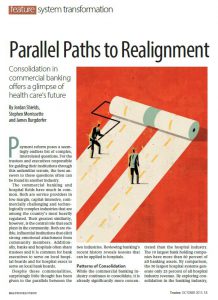Consolidation in Commercial Banking Offers a Glimpse of Health Care’s Future
 Payment reform poses a seemingly endless list of complex, interrelated questions. For the trustees and executives responsible for guiding their institutions through this unfamiliar terrain, the best answers to those questions often can be found in another industry.
Payment reform poses a seemingly endless list of complex, interrelated questions. For the trustees and executives responsible for guiding their institutions through this unfamiliar terrain, the best answers to those questions often can be found in another industry.
The commercial banking and hospital fields have much in common. Both are service providers in low-margin, capital-intensive, commercially challenging and technologically complex industries that are among the country’s most heavily regulated. Their greatest similarity, however, is the central role that each plays in the community. Both are visible, influential institutions that elicit strong emotional attachment from community members. Additionally, banks and hospitals often share trustees and it is common for bank executives to serve on local hospital boards and for hospital execs to serve on local bank boards.
Despite these commonalities, surprisingly little thought has been given to the parallels between the two industries. Reviewing banking’s recent history reveals lessons that can be applied to hospitals.
Patterns of Consolidation
While the commercial banking industry continues to consolidate, it is already significantly more concentrated than the hospital industry. The 10 largest bank holding companies have more than 80 percent of all banking assets. By comparison, the 50 largest hospital systems generate only 25 percent of all hospital industry revenue. By exploring consolidation in the banking industry, we can identify patterns that likely will emerge in the formation of larger hospital companies in the coming decade.